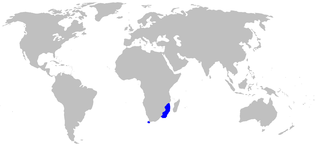Hypostomus punctatus, the suckermouthed catfish, is a tropical fish belonging to the armored suckermouth catfish family, Loricariidae. Hypostomus punctatus is a freshwater fish native to South America, in the coastal drainages of southeastern Brazil and Uruguay. It is one of a number of species commonly referred to as "plecostomus" or "common pleco" by aquarists.

The channel catfish, known informally as the "channel cat", is North America's most abundant catfish species. It is the official fish of Kansas, Missouri, Nebraska and Tennessee. The channel catfish is the most fished species of catfish in the United States, with around 8 million anglers angeling them per year. The popularity of channel catfish for food has contributed to the rapid expansion of this species' aquaculture in the United States. It has also been widely introduced to Europe, Asia and South America, and many countries consider it an invasive species.

The white-spotted Izak or African spotted catshark is a species of shark belonging to the family Pentanchidae, the deepwater catsharks. It is found in the western Indian Ocean off the coasts of Natal, South Africa, southern Mozambique, Madagascar, Kenya, and Tanzania between latitudes 4° S and 37° S, at depths of between 220 and 440 m. It can grow up to 35 cm in length.

The spotted sunfish, also known as a stumpknocker, is a member of the freshwater sunfish family Centrarchidae and order Perciformes. The redspotted sunfish, redear sunfish and pumpkinseed sunfish are its closest relatives. Lepomis punctatus is olive-green to brown in color with black to reddish spots at the base of each scale that form rows of dots on the side. The scientific name punctatus refers to this spotted pattern. It was first described in 1831 by Valenciennes.

Agabus punctatus is a species of predaceous diving beetle in the family Dytiscidae. It is found in North America.
Orthocis punctatus is a species of minute tree-fungus beetle in the family Ciidae. It is found in North America.
Eugnamptus punctatus is a species of leaf rolling weevil in the beetle family Attelabidae. It is found in North America.

Tylos punctatus is a species of woodlouse in the family Tylidae. It is found in Central America, North America, South America, and Mexico.

Euxenus punctatus is a species of fungus weevil in the beetle family Anthribidae. It is found in North America.

Epipocus punctatus is a species of handsome fungus beetle in the family Endomychidae. It is found in Central America and North America.

Dendrophilus punctatus is a species of clown beetle in the family Histeridae. It is found in Europe and Northern Asia and North America.
Hylaeus punctatus is a species of hymenopteran in the family Colletidae. It is found in North America.

Prostephanus punctatus is a species of horned powder-post beetle in the family Bostrichidae. It is found in North America.
Lacconotus punctatus is a species of beetle in the family Mycteridae. It is found in North America.
Tricorynus punctatus is a species of beetle in the family Ptinidae. It is found in North America.
Aulonothroscus punctatus is a species of small false click beetle in the family Throscidae. It is found in North America.
Cryptolestes punctatus is a species of lined flat bark beetle in the family Laemophloeidae. It is found in North America.
Ceruchus punctatus is a species of stag beetle in the family Lucanidae. It is found in North America.
Pseneo is a genus of aphid wasps in the family Psenidae. There are more than 20 described species in Pseneo.

Croton punctatus, commonly called beach-tea or gulf croton, is a species of flowering plant in the spurge family (Euphorbiaceae). It is native to the Western Hemisphere, where it is found in coastal areas from the Southeastern United States south to Colombia, as well as in Bermuda and the Caribbean. Its natural habitat is on beaches and sand dunes.









